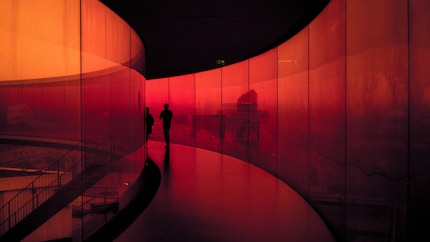
Background information
Focus Week: rolling out the red carpet for – the colour red
by Oliver Fischer

Red is the colour of strong emotions; the colour of love and rage. It’s also the only colour ever to be scientifically proven to spark a physiological reaction in our bodies.
Christine Mohr, Professor of Psychology at the University of Lausanne, has been researching the link between emotions and colours and their effects for over ten years. By polling 12,000 people in 90 countries, she and her colleagues have demonstrated that colour associations are very similar across cultures. Red symbolises love and anger everywhere in the world except Nigeria, where, likely as a result of local rituals, it’s also associated with fear.
Despite fascinating results, colour research can be frustrating at times. While self-help books and commercial colour therapies tout the healing or calming properties of every colour of the rainbow, little of this has been scientifically proven. «I really didn’t think we’d find anything – I thought the influence of colour would be based on abstract language associations and culture-based learning,» says Christine.
Using a commercial set of colour discs, the research team put the effect of much-advertised colour therapy to the test. The results were sobering. As the «therapy» also worked without showing participants the discs, the colours themselves were shown to have no effect. Although the scientists noted a reduction in the 60 participants’ stress levels during the three-week research phase, exactly the same effect was recorded in participants who weren’t shown any coloured discs. The fact that the coloured discs were still perceived as calming, stimulating or mood-enhancing was most likely due to the meditative nature of the therapy, which included positive, calming suggestions and soothing background music. In other words, nothing came of it – the colours themselves had no demonstrable impact. Until red came into the mix.
As yet, red is the only colour ever proven to evoke a physical reaction in the body. That’s what makes the colour so unique. After Christine’s research group’s study on emotions and colours revealed red was associated with visceral emotions like love, passion, anger and hate across almost all cultures, they were keen to find out whether the colour has an immediate effect on us too. Just a few years ago, this would’ve been a tricky question to answer. Entire rooms would’ve needed to be painted red or in other colours for comparison purposes, in order to carry out a controlled experiment. Thanks to virtual reality (VR), however, it’s now possible to do exactly that.

The researchers gave 60 test subjects VR goggles, which were used to place them in a red or blue environment. They then used electrodes to measure changes in the participants’ skin conductance in the blue and red rooms. In neuroscience, skin’s electrical conductance is used as a measure of arousal. And yep, you guessed it, certain shades of red impacted it. Blue, on the other hand, had no effect. Red’s association with a heightened state of arousal provides clues as to why the colour is linked to such opposing emotions like love and hate. Both feelings involve intensified arousal as well as the willingness to take action.
So, what does all of this mean? Certainly that the influence of the colour red is different from that of other colours. Christine had suspected this for a long time. Past studies have shown that newborn babies recognise and pay attention to the colour red. Meanwhile, they ignore blue. Biological mechanisms like this only make sense if red has a special evolutionary significance.
For almost two decades, sports psychologists have been working on the question of whether wearing red makes athletes more likely to win. In 2005, scientists Russell Hill and Robert Barton published a highly regarded study pointing out that Olympic combat sportspeople wearing red jerseys won more frequently than competitors in blue.
Much to the delight of athletes, who then started dreaming of stepping onto the winners’ podium in red shirts. Even Jürgen Klinsmann, former coach to Germany’s national football squad, replaced the team’s traditional black jersey with a red variety in 2006 (article in German). However, further studies revealed the issue isn’t quite that simple after all. Sometimes wearing red would bring a team to victory, while in another context, the colour was more of a hindrance or had no effect on the results.

However, a long-term analysis spanning 55 years revealed that English football teams clad in red shirts won more often than statistically expected. The reason why, however, is unclear. «When we wear red, it’s not just about winning – it’s also about what we’re signalling to our opponent,» says Christine. «It’s not necessarily the case that red teams are superior at attacking. It could also be that the opposing team are less able to defend when they see red.»
According to Christine, red’s association with dominance is apparent when observing men with red ties. Her favourite example of this is an image taken at the press conference between Britain’s ex-Prime Minister Theresa May and former US President Donald Trump. She was wearing a bright red suit, he a deep red tie. «The question is: is the red clothing supposed to indicate a willingness to go on the attack or to mount a vehement defence?» Christine says.
A study of 73 athletes at the University of Sunderland shows biological mechanisms could also be at play here. Participants were given the choice of wearing either a red or blue jersey for a sports performance test. Saliva samples taken beforehand revealed that athletes who’d gone for the red shirt had higher testosterone levels in their blood from the outset. Testosterone is a male sex hormone associated with aggression and readiness to mate. As it turned out, the red shirts didn’t offer any advantage in terms of actual performance. Subsequently, the scientists hypothesised that wearing red only has a positive impact in competitions with a direct opponent. Since a rival competitor in red would be perceived as a strong opponent (as a study has now demonstrated), it could limit the performance of the person not wearing the colour.
Whatever the case, one thing’s for sure: red is a colour of contradictions. It means «stop» and «go», represents love and hate, poison and sex, danger in the form of poisonous plants and rewards in the form of ripe, sweet fruit. In an area so rife with dichotomy, there’ll be plenty of exciting questions for psychology professor Christine Mohr and her team to investigate in future. However, there’s one frequently asked question she’s already able to answer: what does your favourite colour say about you? According to her research, absolutely nothing.
This article was published as part of our Focus Week dedicated to the colour red. Seven days, seven stories. Read more about our red-themed week and all the articles published so far here:
Header image: Christian Walker
Research diver, outdoor guide and SUP instructor – I love being in, on and around water. Lakes, rivers and the ocean are my playgrounds. For a change of perspective, I look at the world from above while trail running or flying drones.
Interesting facts about products, behind-the-scenes looks at manufacturers and deep-dives on interesting people.
Show all
Background information
by Stephanie Vinzens

Background information
by Pia Seidel

Background information
by Martin Jungfer